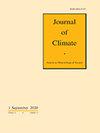Impact of Westward-Propagating ISO over Mid-High-Latitude Eurasia on SSW during Boreal Winter
IF 4.8
2区 地球科学
Q1 METEOROLOGY & ATMOSPHERIC SCIENCES
引用次数: 0
Abstract
In this study, the impact of intraseasonal oscillation (ISO) over mid-high-latitude Eurasia on stratosphere sudden warming (SSW) events during boreal winter is examined based on the NCEP–NCAR reanalysis data. It is found that the dominant ISO periodicity is 10–30 days. By extended empirical orthogonal function, two leading ISO modes with opposite directions of westward and eastward propagation are extracted. Since the eastward-propagating mode was involved by previous studies, this study is focused on the westward-propagating one. As revealed, the westward-propagating ISO propagates from the Canadian Arctic Archipelago to western Europe, which is dominated by waves 1–2. The analysis of lead–lag correlation and phase division indicates that SSW events prefer to occur at the time of lagging the westward-propagating ISO phase 2 by 7–9 days. The diagnosis of the dynamic process of ISO impacting SSW suggests that during the westward journey of the ISO, the corresponding pattern leads to sea ice loss over the Barents–Kara Sea, which emanates upward-propagating planetary waves. At the same time, the ISO circulation expands the easterly anomalies, which weakens westerly flow that favors the planetary waves of wave 1 and wave 2 propagating upward into the stratosphere to affect the onset of SSW. By applying the subseasonal-to-seasonal (S2S) reforecast data from the ECMWF model, the probability density functions of zonal wind anomaly verify the impact of westward-propagating ISO on SSW. The intraseasonal oscillation (ISO) is a vital prediction source for the forecast of extreme weather and climate in both the troposphere and the stratosphere, but the relationship between the mid-high-latitude one and stratospheric extreme weather events lacks research. The purpose of this study is to understand how the ISO over mid-high-latitude Eurasia affects the stratosphere sudden warming (SSW). Our results find that the westward-propagating ISO can impact the onset of SSW events by leading to sea ice loss over the Barents–Kara Sea and the expansion of easterly anomalies. This provides a new clue for the extended-range forecast of SSW.中高纬度欧亚大陆向西传播的ISO对寒带冬季SSW的影响
本研究基于NCEP–NCAR再分析数据,研究了欧亚大陆中高纬度季节内振荡(ISO)对北方冬季平流层突然变暖(SSW)事件的影响。研究发现,ISO的主要周期为10–30天。通过扩展的经验正交函数,提取出两个向西和向东传播方向相反的主导ISO模式。由于以往的研究都涉及到向东传播模式,因此本研究将重点放在向西传播模式上。如图所示,向西传播的ISO从加拿大北极群岛传播到西欧,西欧由1-2波主导。超前-滞后相关性和相位划分的分析表明,SSW事件更倾向于发生在向西传播的ISO第2阶段滞后7-9天的时候。对ISO影响SSW的动态过程的诊断表明,在ISO向西移动的过程中,相应的模式导致巴伦支-卡拉海的海冰损失,并向上传播行星波。与此同时,ISO环流扩大了向东异常,削弱了有利于第1波和第2波行星波向上传播到平流层的西风流,从而影响SSW的爆发。通过应用ECMWF模型的子季节到季节(S2S)重预报数据,纬向风异常的概率密度函数验证了向西传播ISO对SSW的影响。季节内振荡(ISO)是对流层和平流层极端天气和气候预报的重要预测来源,但中高纬振荡与平流层极端天气事件之间的关系缺乏研究。本研究的目的是了解中高纬度欧亚大陆上空的ISO如何影响平流层突然变暖(SSW)。我们的研究结果发现,向西传播的ISO会导致巴伦支-卡拉海的海冰流失和向东异常的扩大,从而影响SSW事件的发生。这为SSW的增程预报提供了新的线索。
本文章由计算机程序翻译,如有差异,请以英文原文为准。
求助全文
约1分钟内获得全文
求助全文
来源期刊

Journal of Climate
地学-气象与大气科学
CiteScore
9.30
自引率
14.30%
发文量
490
审稿时长
7.5 months
期刊介绍:
The Journal of Climate (JCLI) (ISSN: 0894-8755; eISSN: 1520-0442) publishes research that advances basic understanding of the dynamics and physics of the climate system on large spatial scales, including variability of the atmosphere, oceans, land surface, and cryosphere; past, present, and projected future changes in the climate system; and climate simulation and prediction.
 求助内容:
求助内容: 应助结果提醒方式:
应助结果提醒方式:


